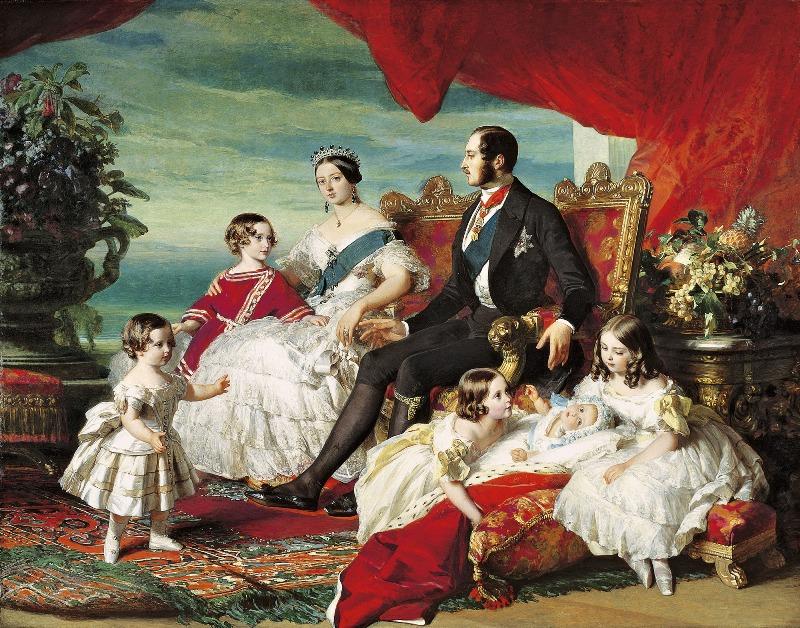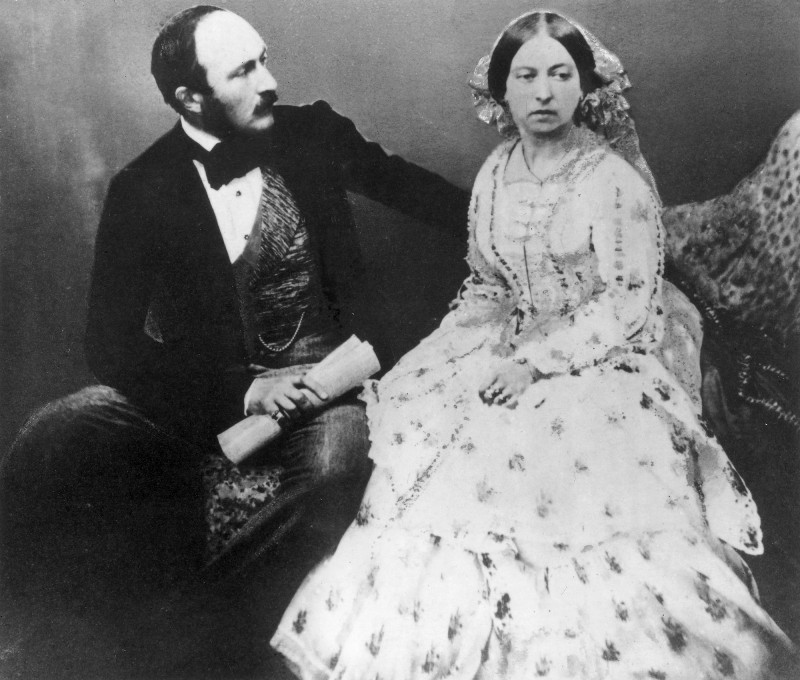Queen Victoria's Children, BBC Two | reviews, news & interviews
Queen Victoria's Children, BBC Two
Queen Victoria's Children, BBC Two
Historical documentary offers a reminder of how not to bring up an heir to the throne

They muck one up, one’s ma and pa. Later this year, all being tickety-boo, a royal uterus will be delivered of the third in line to the throne. The media in all its considerable fatuity will ponder the best way to bring up such an infant in the era of, for instance, Twitter. Full marks go to the BBC’s history department for mischievously lobbing this cautionary little gem into the pot. Queen Victoria’s Children is a three-part manual in how not to raise a future monarch.
Queen Victoria was of course a paragon of fecundity. Sadly, her womb was also a factory for discord, misery and, ultimately, a world war. All the historians who mustered here were agreed that the blame falls at the feet of the parents. The young Victoria, walled up in Kensington Palace, was in the habit of addressing her remote mother as "Duchess", while Albert watched his sexaholic father throw over his mother, deemed too old at 21. Combined in the petri-dish of the newly-weds' own union, these formative experiences created a belief in child-rearing as a kind of parricidal corrective. The idea was to mint a series of exact photocopies of themselves. The thinking turned out flawed.
 The fount of Victoria’s problems with her children was her inordinate fondness for her husband, whom she fancied something rotten (pictured right, the happy couple). Having had in childhood “no scope for my very violent feelings of affection”, she fell with ravenous intensity on the manly swain from jumped-up little Saxe-Coburg who, she noted with a shudder of bliss, wore nothing under his pantaloons. (To illustrate this, there was a helpful shot of a sculpted arse.) Result: nine nippers, who got in the way, for years and years.
The fount of Victoria’s problems with her children was her inordinate fondness for her husband, whom she fancied something rotten (pictured right, the happy couple). Having had in childhood “no scope for my very violent feelings of affection”, she fell with ravenous intensity on the manly swain from jumped-up little Saxe-Coburg who, she noted with a shudder of bliss, wore nothing under his pantaloons. (To illustrate this, there was a helpful shot of a sculpted arse.) Result: nine nippers, who got in the way, for years and years.
Their mother, we learned, had “a totally insurmountable disgust” for the business of feeding them au naturel. Her breasts, an expert explained, were there for Albert. The recipient of this regal privilege was not popular upon his arrival in England. A satirist with a certain lack of deference commentated on the foreign invasion of the virgin queen: “he entered by Bushey, advanced via Maidenhead, penetrated through Virginia Water and left Staines behind.” Phwoar. Never mind that the whole brood would speak English all their lives with a distinctly Teutonic accent, the royal couple set about establishing their growing family as a beacon of British normality with which the growing middle classes might identify. In this they had help from Winterhalter (see main picture), Landseer and the newfangled photograph (pictured below left), prints of which were disseminated by the royal PRs of the Victorian age.
There was a reason for all this image management. While royal households all over Europe succumbed to revolution, Victoria worked to extinguish the unpopular memory of her dissolute uncles George IV and William IV. Not that the Hanoverian stain was so easily erased. Victoria’s volcanic hissy fits – which caused furious and frequent rows with Albert - were thought to come freighted with the haunting taint of George III's malady. Actually she was perfectly sane but, being almost permanently up the duff, just cross a lot.
 Denied a role in affairs of state, Albert instead governed his wife. He duly quashed all her flighty spontaneity till what was left was a frumpy, grumbling housewife. Her constant gripe was about children whose personalities would insist on not turning out to order. Most egregiously of all, it was the young Bertie’s fondness for skirt which, in her view, helped send Albert to an early grave (Victoria having previously dismissed her husband's chronic illness as malingering).
Denied a role in affairs of state, Albert instead governed his wife. He duly quashed all her flighty spontaneity till what was left was a frumpy, grumbling housewife. Her constant gripe was about children whose personalities would insist on not turning out to order. Most egregiously of all, it was the young Bertie’s fondness for skirt which, in her view, helped send Albert to an early grave (Victoria having previously dismissed her husband's chronic illness as malingering).
Queen Victoria’s Children is popular television history at its most seductive. Once past the breathless tabloid intro with which a jumpy modern audience must apparently be grabbed by the lapels, producer/director Lucy McDowell launched into a persuasive portrait of a colourful marriage. To help tell the story she has assembled a small army of historians and biographers – I counted 10 – all deft in the fine art of the soundbite. Victoria must be big business, because none of them seemed to be drawn by affection to their subject, at whose absurdities they cheerfully scowled, sneered and scoffed. The loftiest putdown in this first part was reserved for the “abnormally backward” future Edward VII, much given to pencil-hurling when asked to do his sums. “He just couldn’t focus his mind," suggested Piers Brandon of Cambridge University. "Perhaps he didn’t really have much of a mind to focus.”
Share this article
The future of Arts Journalism
You can stop theartsdesk.com closing!
We urgently need financing to survive. Our fundraising drive has thus far raised £49,000 but we need to reach £100,000 or we will be forced to close. Please contribute here: https://gofund.me/c3f6033d
And if you can forward this information to anyone who might assist, we’d be grateful.

Subscribe to theartsdesk.com
Thank you for continuing to read our work on theartsdesk.com. For unlimited access to every article in its entirety, including our archive of more than 15,000 pieces, we're asking for £5 per month or £40 per year. We feel it's a very good deal, and hope you do too.
To take a subscription now simply click here.
And if you're looking for that extra gift for a friend or family member, why not treat them to a theartsdesk.com gift subscription?
more TV
 The Count of Monte Cristo, U&Drama review - silly telly for the silly season
Umpteenth incarnation of the Alexandre Dumas novel is no better than it should be
The Count of Monte Cristo, U&Drama review - silly telly for the silly season
Umpteenth incarnation of the Alexandre Dumas novel is no better than it should be
 The Narrow Road to the Deep North, BBC One review - love, death and hell on the Burma railway
Richard Flanagan's prize-winning novel becomes a gruelling TV series
The Narrow Road to the Deep North, BBC One review - love, death and hell on the Burma railway
Richard Flanagan's prize-winning novel becomes a gruelling TV series
 The Waterfront, Netflix review - fish, drugs and rock'n'roll
Kevin Williamson's Carolinas crime saga makes addictive viewing
The Waterfront, Netflix review - fish, drugs and rock'n'roll
Kevin Williamson's Carolinas crime saga makes addictive viewing
 theartsdesk Q&A: writer and actor Mark Gatiss on 'Bookish'
The multi-talented performer ponders storytelling, crime and retiring to run a bookshop
theartsdesk Q&A: writer and actor Mark Gatiss on 'Bookish'
The multi-talented performer ponders storytelling, crime and retiring to run a bookshop
 Ballard, Prime Video review - there's something rotten in the LAPD
Persuasive dramatisation of Michael Connelly's female detective
Ballard, Prime Video review - there's something rotten in the LAPD
Persuasive dramatisation of Michael Connelly's female detective
 Bookish, U&Alibi review - sleuthing and skulduggery in a bomb-battered London
Mark Gatiss's crime drama mixes period atmosphere with crafty clues
Bookish, U&Alibi review - sleuthing and skulduggery in a bomb-battered London
Mark Gatiss's crime drama mixes period atmosphere with crafty clues
 Too Much, Netflix - a romcom that's oversexed, and over here
Lena Dunham's new series presents an England it's often hard to recognise
Too Much, Netflix - a romcom that's oversexed, and over here
Lena Dunham's new series presents an England it's often hard to recognise
 Insomnia, Channel 5 review - a chronicle of deaths foretold
Sarah Pinborough's psychological thriller is cluttered but compelling
Insomnia, Channel 5 review - a chronicle of deaths foretold
Sarah Pinborough's psychological thriller is cluttered but compelling
 Live Aid at 40: When Rock'n'Roll Took on the World, BBC Two review - how Bob Geldof led pop's battle against Ethiopian famine
When wackily-dressed pop stars banded together to give a little help to the helpless
Live Aid at 40: When Rock'n'Roll Took on the World, BBC Two review - how Bob Geldof led pop's battle against Ethiopian famine
When wackily-dressed pop stars banded together to give a little help to the helpless
 Hill, Sky Documentaries review - how Damon Hill battled his demons
Alex Holmes's film is both documentary and psychological portrait
Hill, Sky Documentaries review - how Damon Hill battled his demons
Alex Holmes's film is both documentary and psychological portrait
 Outrageous, U&Drama review - skilfully-executed depiction of the notorious Mitford sisters
A crack cast, clever script and smart direction serve this story well
Outrageous, U&Drama review - skilfully-executed depiction of the notorious Mitford sisters
A crack cast, clever script and smart direction serve this story well
 Prost, BBC 4 review - life and times of the driver they called 'The Professor'
Alain Prost liked being world champion so much he did it four times
Prost, BBC 4 review - life and times of the driver they called 'The Professor'
Alain Prost liked being world champion so much he did it four times

Add comment